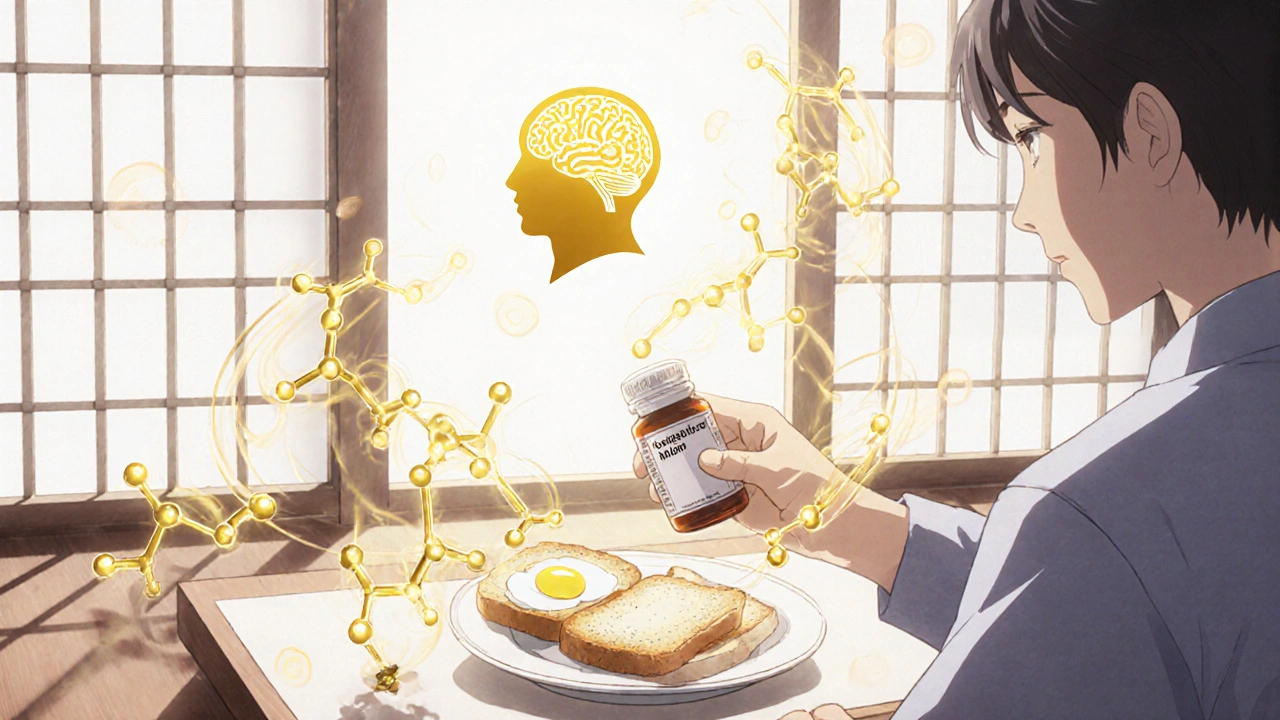For people with Parkinson’s disease taking levodopa, what you eat can make a real difference in how well you move. It’s not just about taking your medicine on time-it’s about what’s on your plate. High-protein meals can quietly sabotage your levodopa, turning good days into unpredictable "off" periods where stiffness, slowness, and tremors come back without warning. This isn’t a myth or a suggestion-it’s a well-documented biological conflict happening inside your body every time you eat chicken, beans, eggs, or cheese with your dose.
Why Protein Blocks Levodopa
Levodopa doesn’t just float freely into your brain. It needs a special transport system called LAT1 to cross the blood-brain barrier. That same transporter is also used by large neutral amino acids (LNAAs)-the building blocks of protein. When you eat a steak, a bowl of lentils, or a protein shake, your digestive system breaks it down into these amino acids. Leucine, isoleucine, phenylalanine, tyrosine-they all rush into your bloodstream at the same time as levodopa. And they’re all fighting for the same doorway into your brain.Think of it like a crowded subway turnstile. If 20 people try to get through at once, the person who arrived first (levodopa) might get pushed back. That’s exactly what happens. Studies show that after a high-protein meal, levodopa absorption drops by 25-40%. Its peak level in the blood is delayed by 45 to 90 minutes. For someone relying on that medicine to move, that delay can mean hours of being stuck in an "off" state.
The problem doesn’t hit everyone at once. It usually shows up after 8-13 years of levodopa use. That’s when the brain’s ability to store and release dopamine starts to fade, and the body becomes more sensitive to small changes in drug delivery. Around 40-50% of long-term levodopa users experience this interference. And it’s not subtle-it can increase motor fluctuations by 32-79%, depending on how it’s measured.
What Counts as a "High-Protein" Meal?
You don’t need a protein-heavy diet to cause trouble. Just 10 grams of protein in one meal can start to interfere. A typical breakfast with two eggs and a slice of toast? That’s about 12 grams. A lunch with grilled chicken (20g), rice, and a side of beans (15g) hits 35 grams. That’s more than enough to trigger a reaction.Studies have shown that meals with over 20 grams of protein cause a significant drop in levodopa bioavailability. One study compared a low-protein breakfast (7.6g) to a high-protein lunch (38.7g). The results were clear: levodopa worked less effectively after the heavy meal. But here’s the twist-some studies found no difference in blood levels of levodopa. That’s because the real bottleneck isn’t always in the gut. It’s at the blood-brain barrier. Even if levodopa gets into your bloodstream, the amino acids from your meal are blocking its way into the brain.
The Three Dietary Strategies That Work
There are three main ways doctors and dietitians help patients manage this problem. None are perfect, but some work better than others.- Low Protein Diet (LPD): This cuts total daily protein to 0.6-0.8 grams per kilogram of body weight. For a 65kg person, that’s about 40-50 grams a day. That’s less than a single chicken breast. While this can improve motor control, it’s hard to sustain. Many people lose weight, feel tired, and miss their favorite foods.
- Protein Redistribution Diet (PRD): This is the most effective approach. Instead of cutting protein, you move most of it to the evening. Daytime meals stay under 7 grams of protein-think fruit, oatmeal, rice cakes, vegetables. Dinner is where you get 80-85% of your daily protein. This works because levodopa is usually taken during the day, when protein is low. At night, when movement isn’t as critical, the protein doesn’t interfere as much. Studies show PRD reduces "off" time by nearly two hours a day and adds 30 minutes of smooth, controlled movement.
- PRD with Low-Protein Products: To make PRD easier, specialty foods like low-protein bread, pasta, and milk are available. These help people feel like they’re still eating "normal" meals. But only 22% of users report real satisfaction with them. They’re expensive, hard to find, and often taste off.
PRD isn’t magic. It works best for people who’ve had Parkinson’s for a while-usually Hoehn & Yahr stages 3 or 4. The longer you’ve been on levodopa, the more likely PRD will help. One study found a 60.7-100% response rate in patients with motor fluctuations.

Why Most People Quit
The hard truth? Most people can’t stick with it. In one review, 68% of patients abandoned strict protein redistribution within a year. Why?- It feels like punishment. Skipping your favorite protein-rich meals-steak, fish, tofu, yogurt-can be emotionally draining.
- Social life suffers. Family dinners, holidays, restaurants-all become minefields. One patient said, "I stopped going out to eat with friends because I couldn’t order anything without feeling like I was breaking rules."
- It’s complicated. Tracking grams of protein isn’t easy. You need to know how much is in each food, when to take your meds, and how your body reacts.
- Weight loss is a real risk. One survey found 31% of people on strict low-protein diets lost more than 5% of their body weight in six months. That’s dangerous for older adults.
And here’s another problem: not everyone needs to do this. Only 40-50% of people with Parkinson’s have a clinically significant interaction. Some people can eat protein with their meds and still feel fine. That’s why blanket advice doesn’t work.
What Actually Works in Real Life
People who succeed with protein management don’t just follow a diet-they build a system.- Timing matters more than restriction. Taking levodopa 30-60 minutes before a meal gives it a head start. Many users report success with taking their morning dose 45 minutes before breakfast. That’s a simple change with a big payoff.
- Use a food and med diary. Track what you eat, when you take your meds, and how you feel. Over time, you’ll spot patterns. Maybe you’re fine with eggs but not with milk. Maybe your afternoon dose works better after a salad than after peanut butter.
- Use apps. MyFitnessPal is used by 47% of patients to track protein. It’s not perfect, but it helps you see where your protein is hiding.
- Try "protein holidays." Instead of cutting protein all day, save it for one meal-usually dinner. That’s what 65% of users who stick with it report as their key strategy.
- Work with a dietitian. People who get professional help are 78% more likely to improve their symptoms. A dietitian can create a plan that fits your culture, your tastes, your lifestyle. One study showed 40% higher adherence when meals included familiar foods from the patient’s background.
What to Avoid
Don’t cut protein if you’re already underweight (BMI under 20). Protein isn’t the enemy-starvation is. And don’t assume all protein is the same. Dairy, soy, eggs, and meat all have different amino acid profiles. Some people tolerate one better than others.Also, don’t stop your meds. Some people think skipping a dose will help, but that makes tremors and stiffness worse. The goal isn’t to avoid levodopa-it’s to make it work better.
What’s Coming Next
Researchers are working on smarter solutions. One Phase II trial (NCT04876321) is testing "protein pacing"-giving small amounts of protein every few hours to keep amino acid levels steady and avoid spikes. Early results show 68% of participants had better control and higher adherence than with traditional diets.Another idea: drugs that bypass the LAT1 transporter entirely. If levodopa could slip into the brain without competing with amino acids, the whole problem would vanish. That’s still years away, but it’s the direction the science is heading.
For now, the best tool you have is awareness. You don’t need to become a nutritionist. But you do need to understand that your plate and your pills are connected. A small change in timing or meal structure can mean more hours of mobility, less frustration, and a better quality of life.
Does all protein interfere with levodopa?
Not all protein affects everyone the same way. The interference comes from large neutral amino acids (LNAAs) like leucine, phenylalanine, and tyrosine, which are found in meat, dairy, eggs, legumes, and soy. Some people tolerate small amounts of protein with their meds, while others need strict timing or redistribution. The key is personal testing-not blanket rules.
Can I eat protein at dinner if I take levodopa in the morning?
Yes, that’s the whole idea behind the Protein Redistribution Diet (PRD). Since levodopa is most needed during the day for movement, keeping protein low in the morning and afternoon helps the medicine work better. Eating protein at dinner, when mobility demands are lower, minimizes interference while still meeting your nutritional needs.
How long does it take to see results from a protein-restricted diet?
Most people notice changes within 2-4 weeks. But it can take up to 6-8 weeks to fully adapt, especially if you’re changing meal timing or switching to low-protein foods. Keeping a daily log of medication times, meals, and motor symptoms helps track progress and identify what’s working.
Will cutting protein cause me to lose muscle or weight?
It can-if you cut too much. A low-protein diet under 0.6g/kg/day risks muscle loss and unintentional weight loss, especially in older adults. That’s why PRD is preferred: it maintains total protein intake but shifts it to the evening. Always work with a dietitian to ensure you’re getting enough calories and nutrients. Monitoring weight weekly is critical.
Should I stop taking levodopa if protein seems to make it worse?
Never stop or change your levodopa dose without talking to your neurologist. The issue isn’t the medication-it’s how your body absorbs it. Adjusting timing, switching to a protein redistribution plan, or changing your meal composition can fix the problem without stopping treatment. Stopping levodopa will make your symptoms worse, not better.
If you’ve been struggling with unpredictable "off" periods, your diet might be part of the puzzle. You don’t need to give up food entirely-but understanding how protein and levodopa interact can give you back control over your movement, your schedule, and your life.






Bro this is wild. I never thought my chicken sandwich at lunch was sabotaging my meds. Took my levodopa at 7am, ate eggs and bacon at 8, and by 10 I was stuck like a rusty hinge. Now I eat oatmeal and fruit in the morning and it’s like I got a new body. 🤯
OMG YES!!! I’ve been doing the protein redistribution thing for 3 months and I can actually walk to my mailbox now 😭 I used to need a cane just to get to the fridge. Dinner is my steak night now and I don’t feel guilty. 🥩
low protien diet is a joke youll lose muscle and get weaker and then you cant move at all even with meds
im not sure if this is real but i tried eating protein at night and my tremors got worse. maybe its just me. i think the meds are just failing me at this point.
Let’s be real - this whole protein thing is just Big Pharma’s way of making you feel guilty for eating food. You think your body can’t handle a little amino acid? You’re not a lab rat. My uncle had PD for 20 years and ate steak with his meds every day. Lived to 87. You’re overcomplicating it.
Also, why is everyone acting like this is new? My grandma did this in the 80s. We just call it ‘eating like a normal human’ now. The real problem? Doctors don’t know how to talk to patients. They hand you a pamphlet and say ‘do this’ and disappear.
And don’t get me started on those ‘low-protein breads.’ They taste like cardboard dipped in regret. Who designed that? A chemist who hates joy? I’d rather starve than eat that stuff.
And yes, I’ve seen people lose 20 pounds on this. That’s not ‘management,’ that’s malnutrition with a fancy label. If your solution requires you to stop enjoying life, it’s not a solution. It’s punishment dressed as science.
Also - who decided protein = evil? Are we suddenly all vegans now? Next thing you know, they’ll say carbs are stealing dopamine too. Next thing you know, we’re all on IV nutrient drips and wearing biohacker vests.
Look - if your meds work with food, eat the damn food. If they don’t, tweak timing. But don’t let some algorithmic diet plan steal your Sunday roast.
And for the love of God, stop tracking grams. Your brain doesn’t need a spreadsheet. It needs a good meal and a nap.
Stop listening to influencers who think PD is a diet problem. It’s a neurological one. Your plate isn’t the enemy. Fear is.
As a neuro dietitian, I can confirm the LAT1 transporter competition is rock solid - 25-40% reduction in bioavailability post-high-protein meal is replicated across multiple RCTs. But here’s what no one says: the *timing* of protein intake relative to levodopa peaks matters more than total daily grams. The 30-60 min pre-meal dosing window is the real MVP. Most patients miss that nuance and blame protein when it’s really poor scheduling.
Also - the protein redistribution diet works because it aligns with circadian dopamine receptor sensitivity. Nighttime dopamine demand is lower, so amino acid competition is physiologically benign. It’s not magic. It’s chronobiology.
And yes, low-protein products are garbage. But you can make your own: rice milk + pea protein isolate + flaxseed is cheaper, tastier, and more bioavailable than commercial ‘PD bread.’ Just sayin’.
I’ve been living with PD for 14 years and this is the first time I’ve seen someone explain the protein-levodopa conflict in a way that doesn’t sound like a textbook. I used to think I was just getting worse. Turns out, my 11am protein shake was the culprit. I switched to a smoothie with banana, oats, and spinach - barely any protein - and now I’m walking without freezing up. I didn’t know my body had a traffic jam at the blood-brain barrier. Mind blown.
Also, I didn’t realize 10 grams of protein could do this. I thought I had to go full vegan. But now I know I can still have cheese on my toast - just not with my meds. That’s a game-changer.
I’ve been using MyFitnessPal to track protein and it’s clunky, but it works. I set alerts for when I hit 7g per meal. It’s not perfect, but it’s better than guessing.
And I agree with the guy who said don’t stop meds. I tried skipping a dose once because I ate too much chicken. Big mistake. I was stuck on the couch for 8 hours. Levodopa isn’t the problem. It’s the timing. The medicine is good. We just need to stop fighting it.
What’s weird is that some days I can eat a burger and still move fine. Other days, a single egg ruins me. I think it’s stress or sleep or just how my body feels that day. So I don’t rigidly follow rules anymore. I track, I adjust, I listen.
And I stopped going to those support groups where everyone just says ‘eat less protein.’ No one talks about the loneliness of it. The way you feel like you’re always the weird one at dinner. That’s the real cost. Not the grams. The isolation.
I wish doctors would say: ‘Try this. See what happens. It’s not a failure if it doesn’t work. We’ll try something else.’ Not ‘do this or your movement will get worse.’
Thank you for writing this. I finally feel like someone gets it.
You’re not alone. I’ve been doing PRD for a year now. Took me 3 months to get the rhythm. Now I have my ‘protein dinner’ every night - salmon, rice, broccoli. And my morning is just fruit, toast with jam, and coffee. I don’t even think about it anymore. It’s just how I live.
And yes, the low-protein pasta tastes like chalk. But I add pesto and parmesan (just a little) and it’s fine. You adapt.
Biggest win? I went from 4 hours of ‘off’ time a day to less than 1. I’m playing guitar again. I didn’t think I ever would. You’ve got this.
And if you’re struggling - DM me. I’ll send you my meal plan. No judgment. We’re all just trying to move.
I’ve been reading this whole thing quietly. I’m 71. Been on levodopa for 11 years. I tried PRD. Didn’t work for me. But I started taking my meds 45 minutes before breakfast - and I eat a tiny bit of protein with it. Now I’m good. No spreadsheets. No weird bread. Just timing.
Some days are better than others. That’s okay. I don’t need to fix everything. I just need to move.
Thank you for writing this. It helped me feel less broken.
Y’all are overthinking this. In America, we eat protein because it’s good. In Europe, they starve themselves on ‘low-protein’ nonsense. My cousin in Italy tried this ‘protein redistribution’ crap and lost 30 pounds. He’s in a wheelchair now. Coincidence? I think not.
Levodopa works fine if you don’t let the government and diet gurus tell you what to eat. Eat steak. Take your meds. Move on. Stop letting science turn your life into a spreadsheet.
Let’s deconstruct this biochemically. The LAT1 transporter’s Km for leucine is 120 μM, while for levodopa it’s 180 μM - meaning leucine has higher affinity. When plasma LNAAs spike postprandially, competitive inhibition occurs. The 25-40% bioavailability drop isn’t anecdotal - it’s pharmacokinetic reality. The fact that some patients don’t respond suggests phenotypic variability in transporter expression - likely influenced by APOE genotype and gut microbiome composition. PRD works because it minimizes peak plasma LNAAs during peak levodopa absorption windows. However, the 68% non-adherence rate reflects a failure of behavioral economics interventions - not patient noncompliance. The solution isn’t more education. It’s nudging - like timed meal alerts synced with med reminders via app. Also, low-protein products are a scam. They’re 3x more expensive and lack essential micronutrients. We need subsidized functional foods, not boutique gluten-free cardboard.
Wow. Just… wow. I can’t believe people are still debating this. This isn’t ‘diet advice.’ This is clinical pharmacology. The fact that some of you are still eating protein with your meds like it’s 1998 is embarrassing. I’ve been a neurologist for 22 years. I’ve seen this destroy lives. You don’t get to ‘feel’ your way out of a transporter blockade. You follow the data. Or you stay stuck. Simple.
And yes - low-protein bread is awful. But so is being unable to tie your shoes. Priorities, people.
Also - MyFitnessPal? Use Cronometer. It’s more accurate. And stop using emojis. This isn’t Instagram.
My mom did the protein thing for 6 months then gave up. Said she missed her meat. I get it. I miss mine too. But now I take my meds before breakfast and eat eggs after lunch. It’s not perfect. But I can walk to the bus. That’s enough
This post is one of the clearest explanations of levodopa-protein interaction I’ve ever read. It’s rare to see science communicated with both precision and humanity.
I’m a grad student in neuropharmacology, and I’ve spent months trying to explain this to patients in clinical rotations. Most just hear ‘avoid protein’ and shut down. But this - this makes it feel like a puzzle you can solve, not a punishment you must endure.
One thing I’d add: the variability in response isn’t just about timing or protein grams. It’s also about gastric emptying. Some people with PD have delayed gastric emptying - which means levodopa sits in the stomach longer, giving amino acids more time to interfere. For them, taking meds on an empty stomach isn’t enough. They need prokinetics like domperidone. But that’s another conversation.
Thank you for writing this. It’s not just helpful. It’s kind.
Just read your comment about gastric emptying - you’re spot on. My neurologist finally tested mine and turns out I’m slow. Now I take a ginger capsule 20 mins before meds. Made a huge difference. Thanks for the tip!